CHARS-A-BANCS PROSP1 FOR THE 1920 SEASON.
Page 8
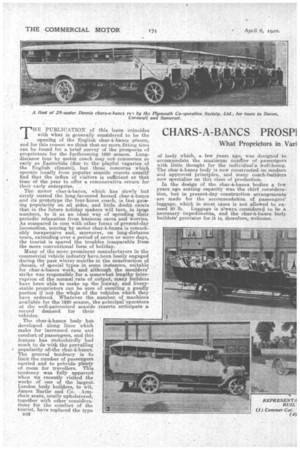
Page 9
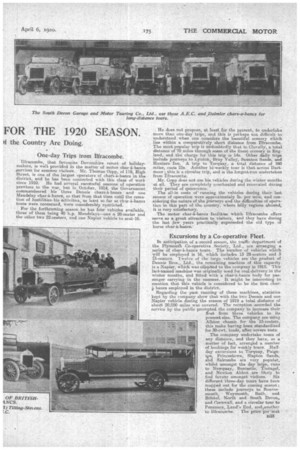
Page 10
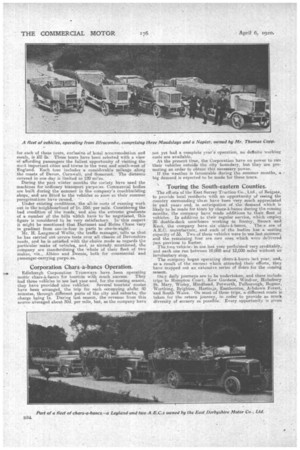
Page 11
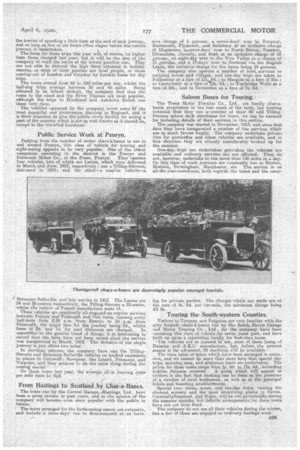
Page 12
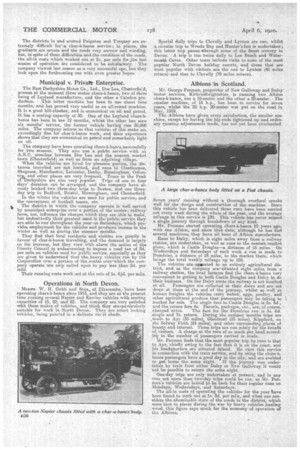
Page 13
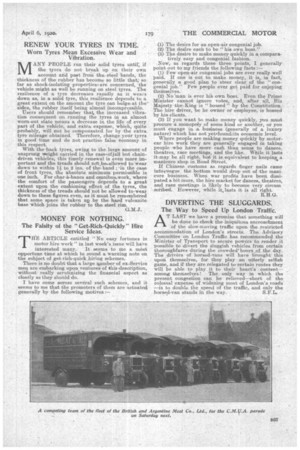
If you've noticed an error in this article please click here to report it so we can fix it.
What Proprietors in Vani the Country Are Doing.
THE PUBLICATION . of this issue coincides with what is generally considered to be the , opening of the English char-h-bancs season, and for this reason we think that no more.fitting time ean be found for a, brief survey of the prospects of proprietors for the forthcoming 1920 season. Longdistance tour by motor coach may not commence so early as Eastertide (due • to the playful vagaries of the English climate), but those concerns which operate locally from popular. seaside resorts usuall
i § find that the nflux of visitors is sufficient at that time of the year to offer a, remunerative return for their early enterprise. ,
. The motor char-k-bancs, which has slowly but surely ousted the long-favoured horsed char-it-bancs and its prototype the four-horse coach, is. fast gaimaing popularity on all sides, and little doubt exists that in the future holiday makers will turn. in large numbers, to it as an ideal way of spending their periodic relaxation from business cares and worries. As compared in cost with other forms of present-day
• locomotion, touring by motor char-a-banes is remarkably inexpensive and, moreover, on long-distance tours, extending over a period of seven or more days, the tourist is spared the troubles inseparable from the more conventional form of holiday.
Many of the more prominent manufacturers in the commercial vehicle industry have been busily engaged during the past winter months in the construction of chassis, of special types in some instances, suitable for char-it.-bancs work, and although the moulders' strike was responsible for a somewhat lengthy, interruption of the normal rate of output, many builders ' have been able to make up the leeway, and live stable proprietors can be sure of securing a goodly portion if not the whgle of the vehicles which they have ordered. Whatever the number of machines available for the 1920 season, the principaroperators at the well-patronized seaside resorts anticipate a record • demand for their.
vehicles. .
The char-h-bancs body has developed along lines which make for increased ease and comfort of passengers, and this feature has Undoubtedly had much to do with the prevailing popularity obthe char-h-ba.ncs. The general tendency is to limit the number of passengers carried and to prbvide plenty of room for travellers. This tendency was fully apparent when vq3 recently visited the works of one of the largest London body builders, to wit, James Bartle and Co. Armchair seats, neatly upholstered, together with other considera, tions for the .comfort of the tourist, have replaced the type
P32 of body which, a few years ago, was designed to accommodate the maximum numter of passengers with little thought for the individual's well-being. The char-h-bancs body is now constructed on modern and approved principles, and many coach-builders now specialize on this class of production.
• In the design of the char-k-bancs bodies a few years ago seating capacity was the chief consideration, but in present-day construction arrangements are made for the accommodation of passengers' luggage, which in most eases is not allowed to exceed 20 lb. Lugga.ge is always considered to be a necessary impedimenta, and the char-à-banes body builders' provision for it is, therefore, welcome. One-day Trips from Ilfracombe.
Ilfracombe, that favourite Devonshire resort of holidaymakers, is well provided in the mattes of motor char-à-banes „services for summer visitors. Mr. Thomas Copp, of 119, High Street, is one of the largest 'operators of chars-à-bancs in the district, and he has been connected with this class of work since 1910. He had several successful seasons of operation previous to the war, but in October, 1914, the Government commandeered his 'three Dennis chars-a-banes and one Mandalay char-ii-banes, so that from that time until the cessation of hostilities-his activities, as least so far as char-a-bancs tours were concerned, were considerably restricted. For the forthcoming season he has fonr vehicles available, three of them being 40 h.p. Man dslays—onea 28-seater and the other two 22-seaters, and one Napier vehicle to seat-16.
He does not propose, at least for the present, to undertake more than one-day trips,and this is perhaps not difficult to understand when one considers the beautiful scenery which lies within a comparatively short distance from Ilfracombe. The most popular trip is undoubtedly that to Clovelly, a total distance of 70 miles through some of the finest, scenery in England, and the charge for this trip is 14s. Other daily tripe include journeys to Lynton,Bray Valley, Swinton Sans, and Hunters Inn. A trip to Torquay, a total distance of 160 miles, costs 25s. Another bi-weekly tour is that across Dart,moor; this is a circular trip, and is the longest-run undertaken from Ilfracombe.
Mr. Copp does not use his vehicles during the winter months at, all. They are completely overhauled and renovated during their period of quiescence. The all-in coats of running the vehicles during their last season of operation were approximately 2s. per mile, and considering the nature of the journeys and the difficulties of operation in this part of the country. where hilly regions abound, it is very satisfactory.
The motor char-a-laancs facilities which. Ilfracombe offers serve as a great attraction to visitors, and they have during the last few years practically superseded the old type of horse char-a-banes.'
Excursions by a Co-operative Fleet.
In anticipation of a-record season, the traffic department of the Plymouth Co-operative Society, Ltd., are arranging a series of char-a-hancs tours. The number of vehicles which WilI be employed is 16, which includes 13 29-seaters and 3 175-seaters. Twelve of the large vehicles are the product of Dennis Bros., Ltd., the remaining machine of this capacity is a Napier, which was stipplied to the COM pany in 1915. This last-named machine was originally used for coal delivery in the winter months, and fitted with a char-a-bancs body for passenger carrying in the summer. It might be interesting to mention that this vehicle is considered to be the first char
banes employed in the district. Regarding the past running of these machines, statistics kept by the company show that with the two Dennis and one Napier vehicleduring the season of 1919 it total distance tif aboitt 20,000 miles was covered. The reception accorded the service by the public prompted the company to increase their fleet from three vehicles to its present size. The company are using Albion chassis for the 15-seaters, this make having been standardized for 30-cwt. loads, after severe tests.
The company undertake tours of any distance, and they have, as a matter of fact, arranged a number of bookings for weekly tours. Halfday excursions to Torquay, Paign Prince,stown, Siapton Sands, and Salcombe are very popular, whilst amongst the day trips, runs to Newquay, Boscastle, Tintagel, and Newton Abbot are likely to find favour amongst visitors. Six different three-day tours have been mapped out for the coming season ; these include journeys to Bournemouth, Weymouth, Bath, and Bilstol, North and South Devon, arid Cornwall, and a circular tour to Penzance, Land's End, and another to Ilfracombe. The price' per seat for each gf these tours, exc'afaive of hotel accommodation and meals, is £2 2e. These tours have been selected with a view of affording passengers the fullest opportunity of visiting the most important cities and towns in the west and south-west of England. Each tour 'includes a considerable mileage along the coasts of Devon, Cornwall, and Somerset,. The distance covered in one day is limited to 120 Int'es. During the past winter months the society have used the machines for ordinary transport purpo:es. Commercial bodies are built during the summer in the company's coachbuilding shops, and are fitted to the vehicles so soon as their slimmer peregrinations have teased.
Under existing conditions the all-in costs of running work out in the neighbourhood of?ls..10d. per mile. Considering the
• bad condition of the roads, and also the extreme gradients. ofa number of the hills which have to be negotiated, this figure is 'considered to be very satisfactory. In thisrespect • it, might be mentionedthat Dartmeet and 1-16Ine Chase vary in gradient from one-in-four in parts to One,in-eight. . .
Mr. H. Langmead. Wallis, the traffic manager, tells us that he has carried out severe tests Over all classes of Devonshire roads, and he is satisfied with the choice made as regards the particular make of vehicle, and, as already mentioned, the company are Standardizing the whole of their fleet of two makes, viz., Albion and Dennis, both for commercial and passenger-carrying .purpo.res.
Corporation. Chars-a-bancs Operation.
Edinburgh Corporation Tramways have been operating moter charszã.-bancs for tourists with much success. They had three vehic'es in use last rear and, for the coming season, they have provided nine vehicles. Several tourists' routes have been arranged, the trip for each occupying aloolit 40 minutes, through different parts of the city and suburbs, the charge being 1s. During Last season, the revenue from this source averaged about 30& per mile, but, as the company have not yet had a complete year's operation, no definite working costs are available.
At the present time, the Corporation have no power to run their vehicles outside the city • boundary, but they are promoting an order to obtain this necessary power.
. If the weather is favourable .during the summer months, a big demand is expected to be made for these tours.
Touring the South-eastern Counties.
The efforts of the East Surrey Traction Co., Ltd., of Reigate, to provide local residents with an opportunity of seeing the country surrounding them have been very much appreciated in past years and, in anticipation of the demand which is likely to be made for tours by chars-a-banes during the coming months, the company have made additions to their fleet. of vehicles.. In addition to their regular service, which employ 20 double-deck omnibuses working in Surrey-, Sussex and Kent, the company have six chsars-a-bancs. There are of A.E.C. mahufacture;. and each of the bodies ha.s a •seating capacity of 33. Two of these vehicles were in use last summer, and the remaining four are new ones which were delivered
just previous to Easter. , The.twg vehicle: in. use last year performed very creditably, and each one ran between 10,000 and 12,000 miles without an involuntary stop.
• The company began operating chars-à-bancs last year, and, as a result of the success which attended their efforts, they have mapped out an extensive series of ttnirs for the coming season.
Omy daily journeys are•to be Undertaken, and these include trips to Hampton Couit, Kew Gardens, Windsor, Holmbury St. Mary, Wisley, Hindhead, Petworth, Pulborough, Bognor, Worthing, Brighton, Hastings, Eastbourne, AshdoWn Forest, and South Wales. On most of these trips, a. different route is taken for the return journey, in order to provide as muck diversity of scenery as possible: Every opportunity is given the. tourist of spending a little time at the end of each journey, and as long, as' five or six hours often elapse before the return: Journey . is undertaken. The fares for these trips this year will, of Course, be higher, than those charged last year, but it will be' the aim of the company to work the series at the lowest 'poSsible cost; They are not abbe to detnand the high fireit obtained in holiday, resorts,asmost of their PatrOns are local people, or those comingout of London and -Croydon by London buses for daytrips.
The tours extend from 65 "to 120 milesper day, whilst the half-day tripsaverage between 35 and 45 miles. Being
• situated in an inland district, the company .find that the tours to the coast and the River Thames are 'most popular, although the trips to Ilindhead and AshdoWn Forest run them very Close.
The Vehicles 'operated by the company cover some hi the 'most beautiful and picturesque districts in England, arid it is :their intention to give the public every facility for seeing a part of the country which is not as well known as it should be, except to the travelled Londoner.
Public Service Work at Penryn.
Judging from the number of motor cbars-k-hanos in use in and around Penryn, this claw of vehicle for touring and sight-seeing appears to be very popular. One of the oldest companies operating in the district is the Penryn and Falmouth Motor Co., of the Praze, Penryn. They operate four vehicles, two of which are Lacres, which were delivered in March and June, 1912, respectively; one a Tilling-Stevens, delivered in 1915; and the other—a smaller .vehicle—a
f•Delaunay-Belleville, put" intoservice in 1912. The Lacres are 24 and 26-seaters respectively, the Tilling-Stevens a 28-seater, whilst tFte vehicle of French manufacture seats 14.
These vehicles are practically •all engagedon regular services between' Penryn and Falmouth and vice versa, running every half-hour from 8.30 a.m. fromPenryn to 10 p.m. front . Falmouth, the .single fare for the journey' being 3c1„ whilst fares of 2d. and Id. for part distances are charged. , In, opposition tothe general trend of things, it is interesting to record that the fares • have not been raised since the service was ininigurated in Mareh, '1912. The distance-of the single
journeY is just about two miles. , ,
In Oreiousseasons, the coinpany have run the TillingStevena and Delaunay-Belleville vehicles on booked excursions to places in Cornwall; Newquay, the Lizard, 'Penzance, and Torpoint,. and they propose to do the same thing -during the coming season. On these tours last. Year,' the averag-e all in 'running 'costs per mile were 1s.
From Hastings to Scotland by Char-a-Banes.
The toms •run' bt the Central Garage,alastings, Ltd., have been a great success in past years, and in the opinion of the company will become even more popular with -the public in future.
The tours arranged for the forthcoming season are extensive, and include a three-days' run to Bournemouth at an inclu-. sive charge of 5 guineas, a seven-days' tour to Torquay, Dartmouth, Plymouth, and. Salisbury at an inclusive charge of 12sguineas, a,sewen-days' tour to North Devon, Taunton, Ilfracombe; Clovelly, and Bath at an inclusive charge .01 12 guineas, an eight-day tour to the .Wye Valley at a charge of 13 guineas. and a 17-days', tour, to Scotland via the English • Lakes, the inclusive charge for the latter being 24 guineas.' The company also operate a number of local,. services to outlyinsa towns and villages, and sone-day trips are taken to Folkestone at a fare of,12s...fid.; to Margate-at a fare of 21s.; to Canterbury at a fare of 12s. 6d.; to Tunbridge Wells at a fare of 10s., and to Tentenden at a fare of 7a. 6d.
Saloon Buses for Touring.
The Trent Motor Traction Co., Ltd, are hardly char-aIs-ancs proprietors in the real sense of the. term, but bearing inimind thatthey use a' number of their 40 odd TillingStevens saloon deck omnibuses for tours, we can be excused for including details of their services in this section. The company was started in November, -1913, and since that date they have inaugurated a number of bus services. which are in much favour locally. The company undertake private hire for partieslas and when vehicles are available, and in this direction they are already considerably booked up for the summer.
One-day. trips are undertaken providing the vehicles are available and ordinary services are not affected.They .do not, however, undertake to run more than 140 miles in a day. On this class of work journeys are constantly run to Buxton, Matlock; Birmingham, Manchester, etc. The service is an all-the-year-round.one, both regardsthe buses and the cater ing for private parties. The charges which are made are at the rate of 4s. 6d. per car-mile, the minimum charge being £5 5s.
Touring the South-western Counties.
Visitors to Torquay, and Paignton are very familiar with the grey -torpedo chars-a-bancs run by the South Devon Garage and Motor Touring Co. Ltd., for the company have been a this th class of vehicle for seven years past, and have built up quite a reputatien locally for first-class tours. Ten vehicles are at pvsent in use, most of these being of Daimler and A.E.C. manufacture but before the' present season is far advanced, 20 machines will be available. The time table ef tours which have been arranged is extensive, and we cannot do more Chan state here that special day trips, morning runs, and afternoon tours are undertaken. The prices for these tours_rarige from 3s. 6d. to 17e, 6d., according torkthe. distance covered. A point which will appeal to visitors is the fact that booking can be' done at the premises of, a number of local tradesmen, as well as at the principal hotels and boarding establishments.
Special two, three, seven, and ten-day tours, visiting the choicest scenery and the most interesting places „in Devon, CornwallpSomerset, and 'Wales will be run periodically during the summer months, but definite arrangements for these tours
have not yet been fixed. The company do not use all their vehicles during the winter, but a few of them are engaged on ordinary haulage work. The districts in and around Paignton and Torquay are extremely difficult for a_ char-à-banes service; in places, the gradients are severe and the roads very narrow and -winding, but, in spite of these difficulties and the condition-of the roads, the all-in costs which worked out. at 2s. per mile for he last season of operation are considered to be satisfactory. The company viewed last season as a very successful ope, but they look upon the forthcoming one with even greater hopes.
Municipal v. Private Enterprise.
The East Derbyshire Motor Co., Ltd., Doe Lea, Chesterfield, possess at the moment three motor chars-a-banes, two of them being of Leyland manufacture, and the other a Caledon pro &lotion. •This latter machine has been in use about nine months, and has proved very useful as an all-round machine. It is a good hill-climber, and is economical on oil and petrol. It has a seating capacity of 39. One of the Leyland chars-abarn* has been in use 12 months, whilst She other has seen siX months' service, the former vehicle having run 30,000 miles. The company inform us that vehicles of this make are exceedingly fine for char-a-basics work, and their experience allows that they are economical on petrol and remarkably light on oil.
The company have been operating chars-a-banes successfully for tw-o seasons. They also run a public servicewith an A.E.C. omnibus between Doe Lea and the nearest market
town (Chesterfield) as well as from an adjoining village. .
When the vehicles are hired for pleasure parties, the distances travelled are not limited., and runs to Cleethorpes, Skegness, Manchester, Leicester, Derby, Birmingham, Coventrss, and other places are very frequent. Tours in the Peak of -Derbyshire are also very popular. Trips ofi one to four days' duration can be . arranged, and the company have already booked two three-day trips to Boston, and one threeday • trip to Bedford, Bristol, Birmingham, and Chesterfield.
In the winter the vehicles are used for public service, and the conveyance of football teams, etc. ' The district in which the -company operate is well served by municipal enterprise over a portion of the routes; railway fares, too, influence the charges which they are able to make, hut undoubtedly their greatest asset is the public service they are able to run. threughout the year on Saturdays, which provides employment for the vehicles and produces income in the winter as Well as sluring.the summer months.
They find that local residents and visitors are greatly in favour of char-a-banes travelling, and the demand is largely on the increase, but they view with alarm the action of the County Council in endeavouring to impose a road tax of 3d. per mile on vehicles used for peblic service, especially as they are given to understand that the. heavy vehicles run by the Corporation over a portion of the.routes over'which the company operate are only called upon to pay less than 2d. per mile.
Their running costs work out at the rate of is. 61d. per mile.
Operations in North Devon.
Mesars. -W. H. Gubb and Sons, of Ilfracombe, have been operating clam-a-banes since 1013, and they are at. the present time running several Napier and Earner vehicles with seating capacities of 15, 20, and 22. The company are very satisfied with these makes of vehicles, and think they are.partieularly suitable for work in North Devon. They are smart looking vehicles, being painted in a delicate vio'et shade. Special daily trips to Clovelly and Lynton are run, whilst a circular trip to Wooda Bay and, Hunter'sInn is undertaken; this latter trip passes hrough some of the finest scenery in Devon: A trip is run twice daily to Lee Beach and Watermouth Caves. Other tours include visits to some of the most popular North Devon holiday resorts, and those that are • most popular with visitors are the one to Lynton (40 miles return) and that to,Clovelly (70 miles return).
Albions in Scotland.
Mr. George Penman, proprietor of New Galloway and Dairy 'Motor services, Kirkcudbrightshire, is running two Albion chars-a-bane; one a 16-seater and the other a 20-seater. The smaller machine, of 16 h.p., has been in service for seven years, whilst -the 20 h.p. 20-seater was put on the road in May, 1919. The Albions have given• every satisfaction, the smaller machine,. except for having the big-ends tightened up -and ordinary running adjustments made, has not yet been overhanled Seven years' running without a thorough overhaul speaks well for the design and construction of the machine. Since this vehicle has been delivered three runs have been carried out every week during the whole of the year, and the average mi i leage n this service is 128. This vehicle has never missed single journey through breakdown of any kind. Mr. Penman started operating chars-ft-basics 10 years ago, with one Albion, and since that date, although he has had several machines, they have all been of Albion manufacture.
Runs to Dairy, which is eight miles away from a railway station, are undertaken' as well as runs to the nearest market
place, which is Castle Douglas—a distance of 16 miles. On Wednesdays and Saturdays of each week a run is made to Dumfries a distance of 24 miles, to the market there, which brings the total weekly mileage up to 128.
The vehicles are operated in an entirely agricultural district, and as the company aresituated eight miles from a railway station, the local farmers find the chars-a-bancs very convenient in getting to both Castle Douglas and Dairy to do their business.. On the Dairy route the railway is not touched at all. Passengers are collected at their doors and are set down at them at the end of the journey, whilst as well as human, freights the vehicles carry butter, eggs, poultry, and other agricultural produce that passengers may be taking to market for sale. The single fare to Castle Douglas is 2s. W.,' and the return fare 4s. Parcels, packages, etc., are, of course,
charged extra. The fare for the Dumfries run is 3s. 6d -mingle and 7s. return. During the summer months trips are ,made to Ayr (35 miles), GlentrouI (33 miles), Kippford, on the Solway Firth (24 miles), and other surrounding places of
beauty and interest. These trips are run solely for the benefit of, visitors. A charge at the rate of so much per head according to the number of passengers carried is made.
Mr. Penman finds that the most popular trip he runs is that to Ayr, chiellY owing to the fact that it is on the coast, and his headquarters are situated inland. He runs this service in connection with the train service, and by using the chars-ibanes passengers have a good day in the city, and are enabled
to .get home the same night. If the journey was undertaken by train from either Dairy or New Galloway it would not be possible to return the same night.
One-day trips are only undertaken at present, and in any ease not more than two-day trips could be run, as Mr. Penman's vehicles are bound to be back for their regular runs on Mondayas Wednesday; and Saturdays. The all-in costs of operating the vehicles for the year have been found to work out at is 3d. per mile, and when one con siders the abominable state of the roads in the district, -which were torn to piece's during the war by heavy vehicles hauling wood, this figure says much for the economy of operation of the Albion.
RENEW YOUR TYRES IN TIME.
Worn Tyres Mean Excessive Wear and Vibration.
MANY PEOPLE run their solid tyres until,. if the tyres do not break up on their own account and past from the. steel bands, the thickness of the rubber has become so little that; so far as shock-isolating properties, are concerned, the vehicle might as well be running on steel tyres. The resilience of a tyre decreases rapidly as it wears down as, in a solid tyre, this resilience depends to a great extent on the amount the tyre can bolgent thesides, the rubber itself being almost incompressible.
Users should remember that the increased vibration consequent on running the tyres in an almost worn-out state means a decrease in the life of every part of the vehicle, and extra expense, which, quite probably, will not be compensated for by the extra tyre mileage obtained. Therefore, change your tyres in good time and do not practise false economy in this respect. With the hack tyres, owing to the large amount of unsprung weight carried in the caseepfiaH but chaindriven vehicles, this timely renewal is even more important and the treads should not,be.allowed to wear down to within 1?,to 2 ins, of the band ; in the case of front tyres, the absolute minimum permissible is one inch. For char-a-banes and omnibus,work, where the comfort of the passengers depends to a great extent upon the cushioning effect of the tyres, the thickness of the treads should not be allowed to wear down to these figures even, as it must be remembered that some space is taken up by the hard vulcanite base which joins the rubber to the steel rim G. M. J.
' MONEY FOR NOTHING.
The Falsity of the " Get-Rich-Quickly " Hire
Service Ideas.
TifE ARTICLE entitled "No easy fortunes in motor hire work" in last week's issue will have interested many. It seems to me a most opportune time at which to sound a warning note on the subject of get-rich-quick ;hiring schemes.
There is no doubt that a. large uumber of ex-Service men are embarking upon ventures of +his 'description, without really scrutinizing the financial aspect as closely as they should do. I have come across several such schemes, and it seems to me that the promoters of them are actuated generally by the following motives : (1) The desire for an open-air congenial job. (2) The desire each to be "his own boss."
(3) The desire to make money quickly in a. comparatively easy and congenial fashion.
Now, as regards these three points, I generally point out to my friends the following facts :— (1) Few open-air congenial jobs are ever really well paid. If one is out to make money, it is, in fact, generally a 'good plan to steer clear of the " congenial job." Fevr perople ever get paid for enjoying themselves.
(2) No 'man is ever hiS own boss. Even the P-rime Minister cannot ignore votes, and, after all, His Majesty the, King is " bossed " by the Constitution. The hire driver, -,be he owner or employee, is bossed by ida clients.
(3) If you want to make money quickly, you must procure a monopoly of some kind or another, or you must engage in a business (generally of a luxury nature) which has not yet.foundiits economic level. Where people are making money quickly by motorcar hire work they are generally engaged in taking people who have more cash than sense to dances, theatres, race meetings, and the like. While it lasts itmay be all right, but it is equivalent to keeping. a manicure shop in, Bond Street, . If Chinese customs as regards finger nails came intoorogue. the bottom would drop out of the manicure business. When war profits have been dissipated a, bit more, the hire market for dances, theatres, and race meetings is likely to became very •circum scribed. However, while at lasts it is all right. R.H.G.
DIVERTING THE SLUGGARDS.
The Way to Speed Up London Traffic.
AT LAST we have a promise that something will be done to check the iniquitous encroachment of the slow-moving traffic upon the restricted accommodation of London's streets. The Advisory Committee on London Traffic has reeonimended the Minister of Transport to secure powers to render it possible to divert the sluggish vehicles from certain thoroughfares during the crowded'hours of the day. The drivers of horsed-vans will have brought this upon themselves, for they play an utterly selfish game, and if they are relegated to certain routes they will be able to play . it to their . heart's , content---' among themselv,es.! The only way in which the present congestion can be relieved—short of the colossal expense of widening most cif London's roads —is to double the speed of the traffic, and only the
horsed-van stands in the way. S.F.L.




























